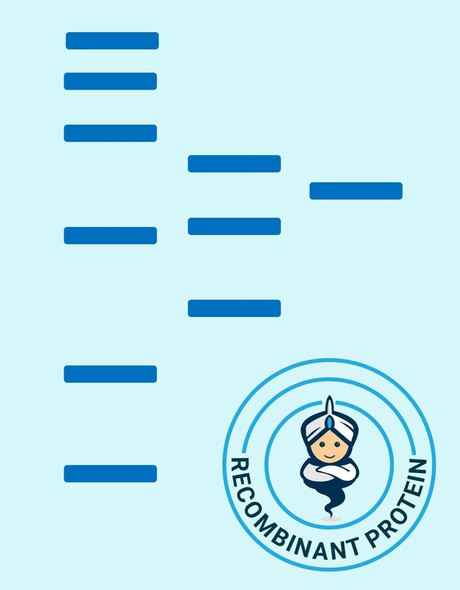Description
| Product Name: | Canine Clusterin Recombinant Protein |
| Product Code: | RPPB0059 |
| Size: | 10µg |
| Species: | Canine |
| Target: | Clusterin |
| Synonyms: | CLI, AAG4, KUB1, SGP2, SGP-2, SP-40, TRPM2, MGC24903, Glycoprotein 80, Gp80, CLU, Clusterin, Apolipoprotein J, Apo-J. |
| Source: | Escherichia Coli |
| Physical Appearance: | Sterile Filtered White lyophilized (freeze-dried) powder. |
| Formulation: | Canine Clusterin was lyophilized from PBS, pH 7.5. |
| Solubility: | Add deionized H2O to a working volume of 0.5mg/ml and let the lyophilized pellet dissolve completely. |
| Stability: | Store lyophilized protein at -20°C. Aliquot the product after reconstitution to avoid repeated freezing/thawing cycles. Reconstituted protein can be stored at 4°C for a limited period of time; it does not show any change after two weeks at 4°C. |
| Purity: | Greater than 95% as determined by SDS PAGE. |
| Amino Acid Sequence: | MKHHHHHHAS DQAVSDTELQ EMSTEGSKYI NKEIKNALKG VKQIKTLIEQ TNEERKSLLS NLEEAKKKKE DALNDTKDSE TKLKASQGVC NDTMMALWEE CKPCLKQTCM KFYARVCRSG SGLVGHQLEE FLNQSSPFYF WMNGDRIDSL LENDRQQTHA LDVMQDSFNR ASSIMDELFQ DRFFTREPQD TYHYSPFSLF QRRPFFNPKF RIARNIIPFP RFQPLNFHDM FQPFFDMIHQ AQQAMDVNLH RIPYHFPIEF PEEDNRTVCK EIRHNSTGCL KMKDQCEKCQ EILSVDCSSN NPAQVQLRQE LSNSLQIAEK FTKLYDELLQ SYQEKMFNTS SLLKQLNEQF SWVSQLANLT QSEDPFYLQV TTVGSQTSDS NVPVGFTKVV VKLFDSDPIT VMIPEAVSRN NPKFMETVAE KALQEYRQKHREE |
Clusterin also named Apolipoprotein J (APO-J) is a 75-80 kD disulfide-linked heterodimeric protein containing about 30% of N-linked carbohydrate rich in sialic acid but truncated forms targeted to the nucleus have also been identified.The precursor polypeptide chain is cleaved proteolytically to remove the 22-mer secretory signal peptide and subsequently between residues 227/228 to generate the a and b chains. These are assembled in anti-parallel to give a heterodimeric molecule in which the cysteine-rich centers are linked by five disulfide bridges and are flanked by two predicted coiled-coil a-helices and three predicted amphipathic a-helices.Across a broad range of species clusterin shows a high degree of sequence homology ranging from 70% to 80%. It is nearly ubiquitously expressed in most mammalian tissues and can be found in plasma, milk, urine, cerebrospinal fluid and semen.It is able to bind and form complexes with numerous partners such as immunoglobulins, lipids, heparin, bacteria, complement components, paraoxonase, beta amyloid, leptin and others. Clusterin has been ascribed a plethora of functions such as phagocyte recruitment, aggregation induction, complement attack prevention, apoptosis inhibition, membrane remodeling, lipid transport, hormone transport and/or scavenging, matrix metalloproteinase inhibition.A genuine function of clusterin has not been defined. One tempting hypothesis says that clusterin is an extracellular chaperone protecting cells from stress induced insults caused by degraded and misfolded protein precipitates.Clusterin is up- or down regulated on the mRNA or protein level in many pathological and clinically relevant situations including cancer, organ regeneration, infection, Alzheimer disease, retinitis pigmentosa, myocardial infarction, renal tubular damage, autoimmunity and others.
Apolipoprotein-J canine Recombinant produced in E.Coli is a single, non-glycosylated, Polypeptide chain containing 433 amino acids and having a molecular mass of 50.6 kDa. The protein is fused to His tag at N-Terminus.The Apolipoprotein-J canine is purified by proprietary chromatographic techniques. The amino acids sequence is identical to UniProtKB/Swiss-Prot entry P25473 amino acids 23�445.
| UniProt Protein Function: | Functions as extracellular chaperone that prevents aggregation of nonnative proteins. Prevents stress-induced aggregation of blood plasma proteins. Inhibits formation of amyloid fibrils by APP, APOC2, B2M, CALCA, CSN3, SNCA and aggregation-prone LYZ variants (in vitro). Does not require ATP. Maintains partially unfolded proteins in a state appropriate for subsequent refolding by other chaperones, such as HSPA8/HSC70. Does not refold proteins by itself. Binding to cell surface receptors triggers internalization of the chaperone-client complex and subsequent lysosomal or proteasomal degradation. When secreted, protects cells against apoptosis and against cytolysis by complement. Intracellular forms interact with ubiquitin and SCF (SKP1-CUL1-F-box protein) E3 ubiquitin-protein ligase complexes and promote the ubiquitination and subsequent proteasomal degradation of target proteins. Promotes proteasomal degradation of COMMD1 and IKBKB. Modulates NF-kappa-B transcriptional activity. Promotes apoptosis when in the nucleus. Inhibits apoptosis when associated with the mitochondrial membrane by interference with BAX-dependent release of cytochrome c into the cytoplasm. Plays a role in the regulation of cell proliferation (). |
| UniProt Protein Details: | |
| NCBI Summary: | This gene encodes a protein that is similar to the human clusterin protein, a secreted chaperone that can also be found in the cell cytosol under certain stress conditions. The human protein has been suggested to be involved in several basic biological events such as cell death, tumor progression, and neurodegenerative disorders. [provided by RefSeq, May 2011] |
| UniProt Code: | P25473 |
| NCBI GenInfo Identifier: | 50979240 |
| NCBI Gene ID: | 442971 |
| NCBI Accession: | NP_001003370.1 |
| UniProt Secondary Accession: | P25473 |
| UniProt Related Accession: | P25473 |
| Molecular Weight: | 51,790 Da |
| NCBI Full Name: | clusterin |
| NCBI Synonym Full Names: | |
| NCBI Official Symbol: | CLU�� |
| NCBI Official Synonym Symbols: | GP80�� |
| NCBI Protein Information: | clusterin |
| UniProt Protein Name: | Clusterin |
| UniProt Synonym Protein Names: | Glycoprotein 80; Gp80 |
| Protein Family: | Clusterin |
| UniProt Gene Name: | CLU�� |
| UniProt Entry Name: |






